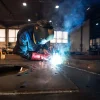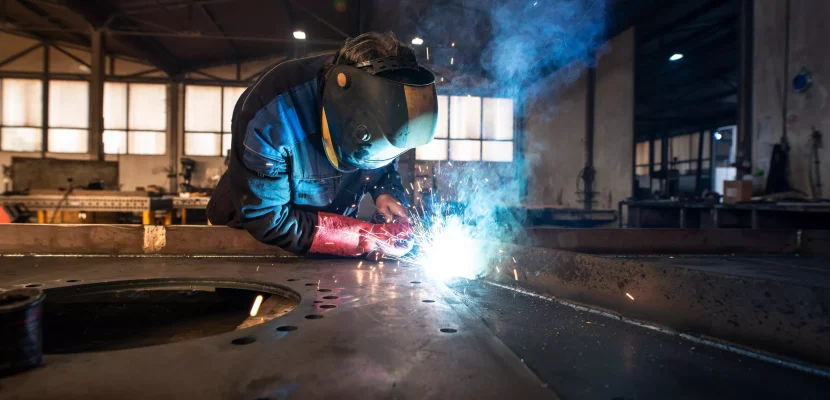Stainless steel fabrication is a crucial industry that includes various processes to create metal structures and components that can enhance the aesthetics of a building and also functionality.
Among these, pressing and folding are two essential techniques due to their versatility and efficiency. Mastering these methods can significantly enhance the quality and functionality of stainless steel and other metal products, making it vital for fabricators to understand their details.
Luckily, Select Alutech’s Head Fabricator, Eddie Wall, is on hand to break down the process.
Pressing in Stainless Steel Fabrication
Pressing, also known as stamping, involves using a press to apply high pressure on a stainless steel sheet to shape it into the desired form. This technique is highly effective for creating intricate designs and patterns on stainless steel surfaces.
The Pressing Process
Select Alutech’s team of expert fabricators take a refined process to ensure consistency in quality throughout the manufacturing process. These steps include:
- Preparation: The stainless steel sheet is cleaned and cut to the appropriate size.
- Die Selection: A die, which is the mold that shapes the metal, is chosen based on the desired outcome.
- Press Setup: The stainless steel sheet is placed on the die, and the press machine is adjusted for the required pressure and speed.
- Pressing: The press applies force to the metal sheet, deforming it to match the die’s shape.
Advantages of Pressing
- Precision: Pressing allows for high precision, making it ideal for complex designs in stainless steel fabrication.
- Efficiency: It is a rapid process, suitable for high-volume production.
- Versatility: Can be used on various metals, including steel, aluminium, and copper.
However, pressing requires significant initial investment in machinery and dies, and is typically more suited for mass production due to the cost involved in creating custom dies.
Folding in Stainless Steel Fabrication
Folding, also known as bending, involves deforming a stainless steel or metal sheet along a straight axis to create angles and shapes.
This technique is pivotal for producing components like brackets, enclosures, and panels in steel metal fabrication.
The Folding Process
- Marking: The stainless steel sheet is marked where the bends are to be made.
- Setup: The sheet is placed in a folding machine or brake press.
- Bending: The machine applies force to bend the sheet along the marked lines.
Types of Folding
- V-Bending: Uses a V-shaped die, suitable for creating simple, straight bends in stainless steel.
- U-Bending: Uses a U-shaped die, ideal for creating channel shapes.
- Edge Bending: The sheet is bent along its edge to create a flange.
Advantages of Folding
- Flexibility: Can be used for small batch production and custom work in steel metal fabrication.
- Cost-Effective: Lower initial investment compared to pressing, as it doesn’t require custom dies.
- Material Conservation: Minimises waste by reducing the need for cutting and welding.
However, folding can be limited by the thickness and type of metal, and achieving extremely tight tolerances can be challenging compared to pressing.
Combining Pressing and Folding in Metal Fabrication
While each technique has its own merits, combining pressing and folding can lead to even more efficient and versatile stainless steel fabrication processes. For instance, pressing can be used to create detailed features and holes, while folding can be employed to shape the overall form of the component. This synergy allows fabricators to leverage the benefits of both techniques, producing high-quality, functional metal products.
Key Takeaways
Pressing and folding are cornerstone techniques in stainless steel fabrication, each offering unique advantages.
Pressing excels in precision and mass production, while folding provides flexibility and cost-effectiveness for smaller runs and custom projects. Understanding and mastering these techniques can open up a world of possibilities in metal fabrication, driving innovation and efficiency in the industry.
As technology continues to advance, these methods continue to evolve, maintaining their relevance and importance in modern steel metal fabrication.
If you have a project in your pipeline that requires bespoke metal fabrication solutions speak to our team today.




Lorem ipsum dolor sit amet, consetetur sadipscing elitr, sed diam nonumy eirmod tempor invidunt ut labore et dolore magna
Lorem ipsum dolor sit amet, consetetur sadipscing elitr, sed diam nonumy eirmod tempor invidunt
Lorem ipsum dolor sit amet, consetetur sadipscing elitr, sed diam nonumy eirmod tempor
Lorem ipsum dolor sit amet, consetetur sadipscing elitr, sed diam nonumy eirmod tempor invidunt